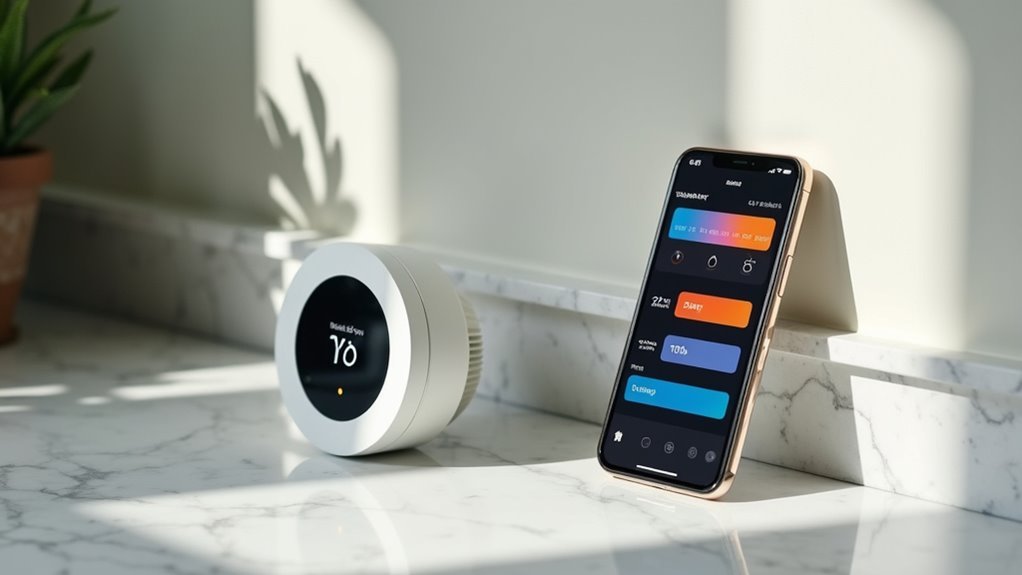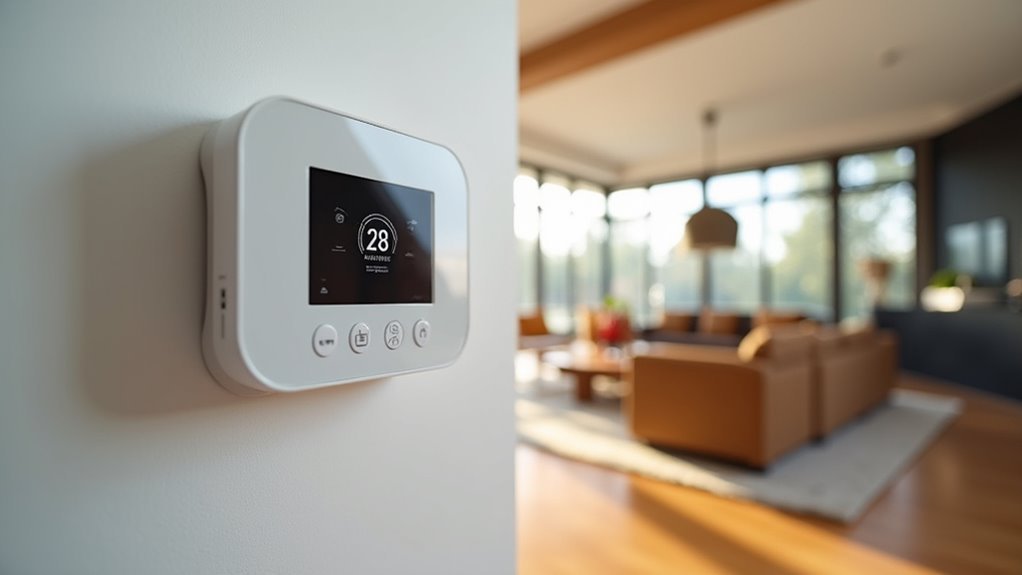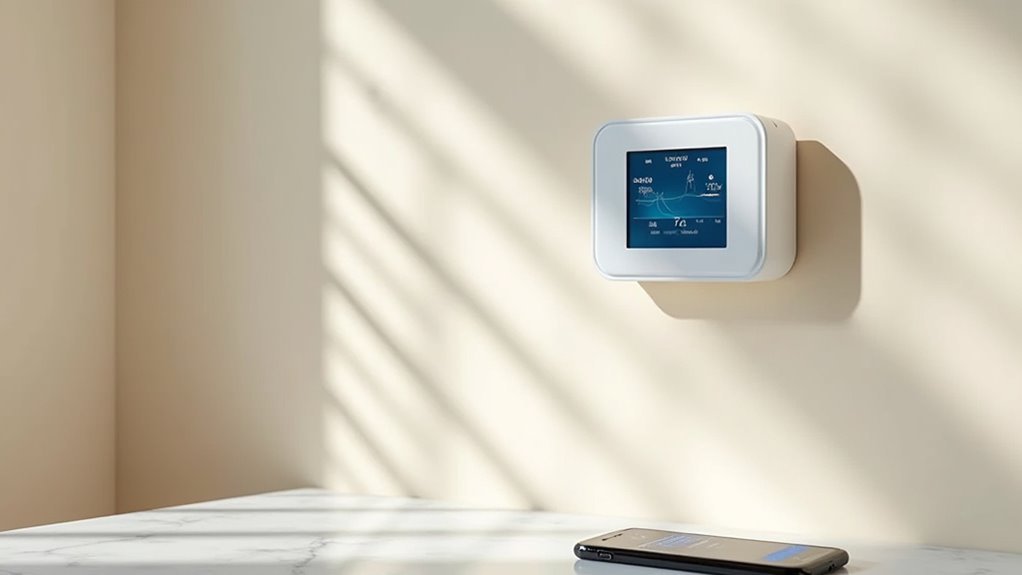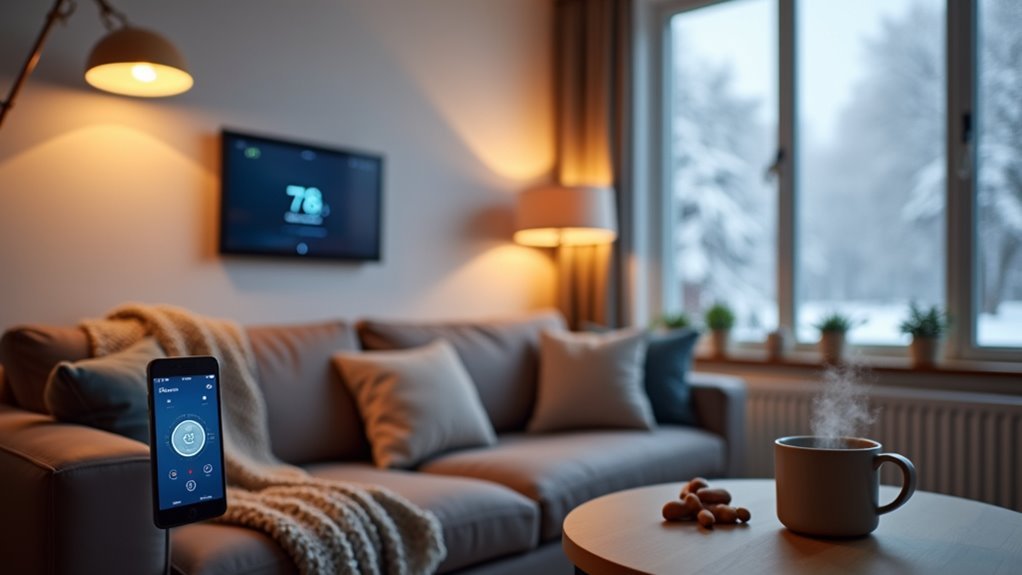You’re probably spending more on heating bills than necessary, and your home’s temperature control isn’t as efficient as it could be. Smart remote heating technology offers powerful solutions, but most people only scratch the surface of what’s possible. The difference between basic thermostat programming and truly optimized smart heating control can mean hundreds of dollars in annual savings—if you know the right strategies to implement.
Set Up Custom Temperature Schedules Based on Your Daily Routine

When you align your smart thermostat’s temperature schedules with your daily routine, you’ll transform how efficiently your home uses energy while maintaining ideal comfort.
Custom temperature schedules let you program specific heating times that match when you’re actually home, ensuring warmth when needed and conserving energy when you’re away.
Program your smart thermostats to automatically lower temperatures during work hours and overnight, then warm up before you return or wake up. This strategic approach prevents unnecessary heating costs while improving indoor air quality and sleep quality.
Most smart thermostats support multiple weekly schedules, accommodating different routines throughout the week.
When effectively programmed, these systems can deliver substantial energy savings—some users report up to 37% reductions in heating usage through proper scheduling.
Take Advantage of Geofencing Technology for Automatic Adjustments
You’ll discover that geofencing technology transforms your smart thermostat into an intelligent system that automatically adjusts temperatures based on your location.
This feature delivers substantial energy savings by reducing unnecessary heating when you’re away, with some homeowners seeing up to 20% lower consumption.
Setting up geofencing requires connecting your smartphone’s location data to your thermostat, but once configured, it’ll handle temperature adjustments without any manual intervention.
How Geofencing Works
Geofencing technology transforms your smart thermostat into an intelligent system that knows exactly when you’re home or away. Using GPS or Wi-Fi signals, it creates a virtual boundary around your property that triggers automatic temperature adjustments based on your location.
When you leave this designated zone, your smart thermostat detects your departure and switches to energy-saving mode, reducing unnecessary heating or cooling costs.
As you approach home, the system recognizes your return and adjusts temperatures to your preferred comfort settings.
You can customize the geofencing boundary size to match your commuting patterns and set specific temperatures for both “away” and “home” modes.
This intelligent automation delivers substantial energy savings, with some homeowners achieving up to 26% reduction in usage through optimized scheduling.
Energy Savings Benefits
Since your smart thermostat can automatically detect when you’re away, you’ll dramatically reduce heating costs without sacrificing comfort.
Geofencing technology enables your system to cut unnecessary energy expenditure by turning down heating when nobody’s home. You can save up to 30% on heating bills since the system only heats when needed.
Smart thermostats with geofencing provide exceptional energy savings through intelligent automation. Your home returns to comfortable temperatures just before you arrive, eliminating wasted energy while maintaining comfort.
The technology also reveals peak usage patterns, helping you make smarter heating decisions. Mobile app notifications alert you when you’re approaching home, allowing preemptive temperature adjustments.
This seamless automation guarantees maximum efficiency without requiring constant manual adjustments, making energy savings effortless.
Setup and Configuration
Setting up geofencing on your smart thermostat requires just a few simple steps through your device’s mobile app. You’ll define virtual boundaries around your home that trigger automatic temperature adjustments when you leave or return.
| Setup Step | Action Required |
|---|---|
| Download App | Install manufacturer’s mobile application |
| Enable Location | Allow GPS tracking permissions |
| Set Boundaries | Define geofencing radius around home |
| Configure Settings | Choose temperature preferences for home/away |
Most smart thermostats let you customize these boundaries based on your commuting patterns. You can adjust the geofencing radius from a few hundred feet to several miles, depending on your preferences. This geofencing technology enables energy savings by automatically reducing heating when you’re away, potentially cutting costs by up to 20% while maintaining comfort when you return.
Monitor Your Energy Usage Patterns Through Built-in Analytics
While many homeowners rely on guesswork to manage their heating costs, smart thermostats eliminate this uncertainty by providing thorough energy analytics that reveal exactly how and when you’re using power.
These analytics features track your energy usage daily, weekly, and monthly, giving you detailed consumption patterns.
You’ll access historical data to identify peak usage times and adjust your habits accordingly.
Install Remote Sensors for Multi-Room Temperature Control

You’ll transform your heating efficiency by installing remote sensors that detect occupancy and temperature in specific rooms throughout your home.
These sensors enable zone-based temperature management, allowing you to heat frequently used areas while reducing energy consumption in unoccupied spaces.
When properly integrated with your smart thermostat, multiple sensors create a cohesive multi-room climate control strategy that responds to your daily routines and occupancy patterns.
Sensor Placement Strategy
Since traditional thermostats only measure temperature at one central location, they can’t account for the varying conditions throughout your home.
Your sensor placement strategy directly impacts energy efficiency and comfort levels throughout multiple rooms.
Position remote sensors in frequently used areas like living rooms and bedrooms where you spend most time. This guarantees heating prioritizes occupied spaces while avoiding energy waste in empty rooms.
You’ll want to place sensors away from direct sunlight, heat sources, and air vents to prevent inaccurate readings that trigger unnecessary heating adjustments.
Strategic sensor placement allows your smart thermostat to create responsive heating zones that adapt to your family’s habits.
This targeted approach can potentially save up to 26% on energy costs while maintaining peak comfort where you need it most.
Zone-Based Temperature Management
Once you’ve established ideal sensor placement, you can leverage these devices to create distinct heating zones that operate independently based on each room’s specific needs.
Zone-based heating transforms your home into a smart ecosystem where remote sensors communicate directly with your thermostat to deliver targeted temperature control. You’ll heat only occupied rooms while reducing energy consumption in unused spaces, achieving up to 37% energy savings with compatible systems like Netatmo.
This approach creates customized heating schedules for each zone, ensuring rooms reach desired temperatures precisely when needed.
You’ll eliminate unnecessary energy expenditure by avoiding heating vacant areas, resulting in lower monthly bills.
Most smart thermostat systems support additional sensors, expanding functionality for room-specific climate requirements and maximizing overall comfort efficiency.
System Integration Benefits
Beyond individual room control, integrating remote sensors across your entire heating system creates a unified network that maximizes both comfort and efficiency. These smart devices work seamlessly with your thermostat to optimize energy use throughout your home, automatically adjusting settings based on occupancy patterns.
| Integration Feature | Benefit | Energy Impact |
|---|---|---|
| Occupancy Detection | Automatic adjustments | Up to 26% savings |
| Geofencing Technology | Location-based control | Reduces waste |
| Personalized Settings | Individual room preferences | Optimized comfort |
When you connect multiple sensors, you’re creating an intelligent ecosystem that learns your habits and responds accordingly. The system dynamically manages temperature control across zones, ensuring you’re only heating spaces when needed while maintaining your preferred comfort levels in occupied areas.
Use Learning Features to Optimize Heating Preferences

While traditional thermostats require constant manual adjustments, smart thermostats with learning features revolutionize your heating control by automatically analyzing your daily routines and temperature preferences.
These devices use machine learning algorithms to predict when you’ll need heating or cooling based on your historical usage patterns, delivering energy savings of up to 26% according to user reports.
Smart thermostats leverage machine learning to analyze your heating patterns, automatically delivering up to 26% energy savings through predictive temperature control.
Your smart thermostat adapts to schedule changes, ensuring comfort when you’re home while conserving energy when you’re away.
Occupancy sensors enhance this process by adjusting heating based on room usage, maximizing comfort in frequently used spaces while minimizing waste elsewhere.
You can refine these preferences by regularly monitoring energy usage reports, helping identify additional opportunities for optimization and further reducing your heating costs.
Configure Weather-Responsive Settings for Outdoor Temperature Changes
As outdoor temperatures fluctuate throughout the day and seasons, your smart thermostat’s weather-responsive settings automatically adjust your heating system to maintain ideal comfort while maximizing energy efficiency.
These intelligent systems use real-time outdoor temperature data and weather forecasts to enhance your heating output without manual intervention. When warmer days arrive, your thermostat will automatically reduce heating, while colder spells trigger increased output to maintain consistent indoor climate.
Smart thermostats integrate with local weather services to respond dynamically to sudden temperature changes. By configuring these weather-responsive settings, you’ll potentially achieve energy savings of up to 37% while ensuring peak comfort.
The algorithms factor in current conditions and forecasted temperatures, preemptively adjusting settings to eliminate guesswork from your heating management.
Enable Open Window Detection to Prevent Energy Waste
When you leave windows open during heating season, your smart thermostat’s open window detection feature recognizes the sudden temperature drop and automatically pauses your heating system to prevent energy waste.
This intelligent technology can reduce your heating costs by 10-15% by avoiding unnecessary heating when windows remain open.
Smart thermostats with this capability send smartphone alerts when open window conditions occur, prompting you to close windows for peak heating efficiency.
The system detects rapid temperature changes caused by drafts and temporarily suspends heating until conditions normalize.
Beyond immediate energy efficiency benefits, open window detection protects your heating system from excessive cycling caused by temperature fluctuations.
This reduces wear and extends equipment lifespan while maintaining consistent comfort levels throughout your home.
Integrate Your Smart Thermostat With Voice Assistants and Home Automation
Since smart thermostats work best as part of a connected ecosystem, integrating yours with voice assistants and home automation platforms transforms how you control your heating system. You’ll gain hands-free control through Amazon Alexa or Google Assistant using simple voice commands.
| Integration Type | Benefits | Examples |
|---|---|---|
| Voice Assistants | Hands-free control | “Alexa, set temperature to 72°” |
| Home Automation | Coordinated routines | Lighting + heating schedules |
| IFTTT Triggers | Custom automations | Auto-adjust when leaving home |
Home automation enhances geofencing capabilities, automatically adjusting temperatures when you’re approaching or leaving. You’ll access sophisticated features like energy reports and remote management through unified app interfaces. By connecting smart thermostats with automation platforms, you create coordinated routines that optimize both energy efficiency and comfort throughout your home.
Regularly Update Software for Enhanced Performance and Security
While connecting your smart thermostat to various platforms maximizes its capabilities, maintaining updated software guarantees these integrations remain secure and perform at their best.
You should regularly update software to protect against security vulnerabilities that could expose your personal data or allow unauthorized access to your heating system.
Most manufacturers release updates that fix bugs, enhance functionality, and introduce new energy-saving features. These improvements can reduce your energy bills while optimizing comfort levels.
Enable automatic updates through your device settings or manufacturer’s app to receive enhancements without manual intervention.
Check your thermostat’s settings periodically for update notifications. This simple maintenance step guarantees enhanced performance, protects against cyber threats, and keeps your smart heating system running efficiently with the latest technological improvements.
Maintain Your HVAC System to Maximize Smart Control Efficiency
Although smart thermostats can enhance your heating schedule and settings, they can’t overcome fundamental issues with your HVAC system that reduce efficiency and waste energy. To maintain your HVAC system effectively, you’ll need consistent upkeep that supports your smart heating controls.
Replace air filters regularly to guarantee efficient airflow and prevent increased energy consumption. Schedule annual professional maintenance to identify potential issues before they compromise your system’s efficiency. Check and seal air leaks in ductwork, windows, and doors that undermine your smart controls’ effectiveness.
| Maintenance Task | Frequency | Impact on Energy Savings |
|---|---|---|
| Filter replacement | Monthly | Up to 15% savings |
| Professional tune-up | Annually | 10-20% efficiency boost |
| Ductwork sealing | As needed | 20-30% heating loss prevention |
Keep your thermostat away from heat sources for accurate readings and monitor settings based on maintenance insights.
Frequently Asked Questions
Is There a Downside to Smart Thermostats?
You’ll face higher upfront costs, potential compatibility issues with older HVAC systems, privacy concerns from data collection, Wi-Fi dependency problems, and additional professional installation expenses that increase your total investment considerably.
Is It Cheaper to Leave Your Thermostat at One Temperature?
No, you’ll spend more keeping your thermostat at one temperature. You can save 5-15% on heating bills by lowering it 10-15°F for eight hours daily when you’re sleeping or away.
What Are the Best Settings for a Smart Thermostat?
Set your smart thermostat to 68°F when home and awake, 62°F when sleeping or away. Use scheduling features, enable geofencing, review energy reports regularly, and experiment with Eco modes for ideal savings.
How Can I Control My Heating Remotely?
You’ll control your heating remotely through your smart thermostat’s smartphone app. Connect it to Wi-Fi, then adjust temperature settings from anywhere with internet access, schedule heating routines, and monitor energy usage patterns.





Leave a Reply